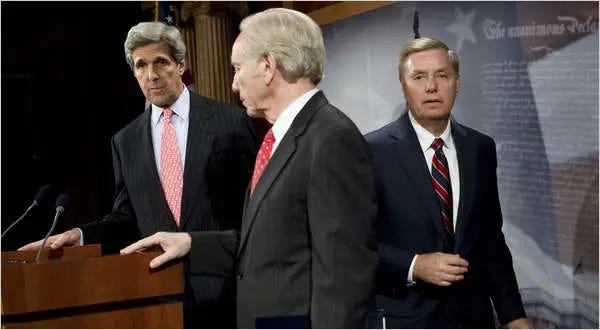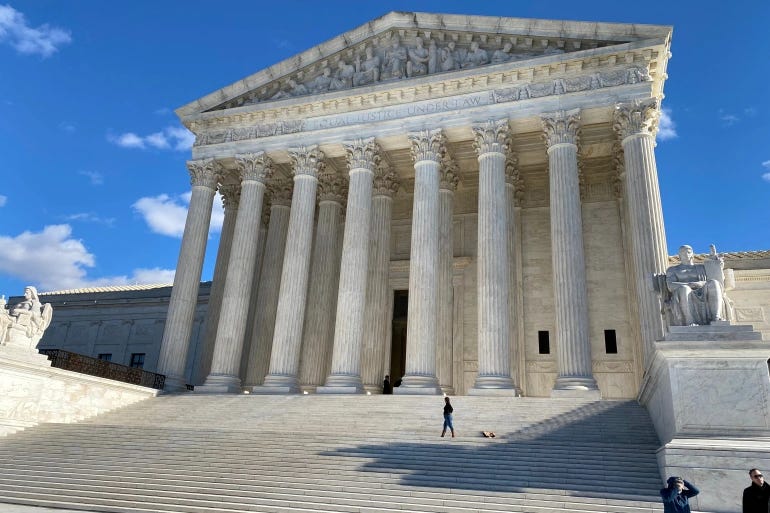#24: What Are The Implications Of This Week's Supreme Court Ruling In West Virginia vs. EPA?
A big Supreme Court decision landed Thursday, which will shape the U.S. Government's ability to regulate emissions. This leads to important realities around coordination, politics and certainty.
PRESSED FOR TIME?
In an enormous two weeks of judgments in the U.S Supreme Court, a 6-3 conservative majority ruled the EPA did not have the authority to regulate power plant emissions in the way they hoped. It’s both a very big deal and not all bad because the judgment stopped short of more sweeping action, and so much action on air quality and emissions reductions are actually taken at the local/city level. Understanding this decision is important for thinking about how hard it will be to see coordinated action in the U.S. for the foreseeable future, but also why this leaves investors and consumers with windows of opportunity if they understand existing trends.
WHAT IS THE KEY HISTORY LEADING UP TO THIS CASE?
The Clean Air Act, which some legal experts call the most powerful environmental law in the world, was enacted in 1970, at the birth of the environmental movement. Since then it has been the source of scores of landmark regulations on air pollution, including soot, smog, mercury and the toxic chemicals that cause acid rain.
The Clean Air Act does not explicitly direct the EPA to regulate carbon dioxide — rather, it more broadly asks the agency to regulate pollutants that “endanger human health.” In 2007, the Supreme Court ordered the EPA to determine whether carbon dioxide fit that description, and in 2009, the agency concluded that it did.
As recently as 2009, the Clean Air Act was generally not viewed by climate policy advocates as a great tool for greenhouse gas regulation; it was a fallback and politically tradable for getting bipartisan Congressional action on climate. The late 2000s feels like a foreign country in many ways, but to refresh: actors such as Sens. John Kerry (D-MA) and Lindsey Graham (R-SC) worked on bipartisan cap and trade bills that never succeeded.
Other 2000s-era proposals included Sen. John McCain (R-AZ), who sponsored multiple global warming pollution reduction bills and advocated significant reductions during his 2008 presidential campaign. Sen. Olympia Snowe (R-ME) also co-sponsored global warming bills in previous Congresses. And in 2006, Sen. Sam Brownback (R-KS) said: “It seems to me just prudent that we recognise we have climate increase and temperature change. We have CO2 loading and we need to reduce the amount of CO2 in the atmosphere.” None of these senators publicly supported action or engaged in serious negotiations with key climate legislation crafters Sens. Kerry, Lieberman, or Graham in 2010. (NB: This history will be important to understand when we reach one of the judgment’s main points).
Unfortunately, there was not a 60-vote supermajority for climate action in the Senate in 2010, a time when the Democratic majority including a substantial number of members from fossil fuel extraction states. In 2010, House Democrats from states like Louisiana, North Dakota, Nebraska approached the Obama White House and recommended they shelve their signature climate change legislation plans. Where are many of those House members today? Defeated anyway, or gerrymandered out of contention as America’s red and blue states have become ever more polarised at the local level.
Obviously, as far as legislative numbers go, we are in no better situation today.
For context, the first Clean Air Act, Clean Water Act, Endangered Species Act, and Resource Conservation and Recovery Act (hazardous waste disposal) were all enacted when unemployment was 6 percent or lower. Another way to say this: it’s historically been hard to pass environmental legislation when the economy is a greater priority for legislators and voters.
President Obama, after unsuccessfully trying to enact a climate change law through Congress, turned to the Clean Air Act, using it to release major regulations on vehicle and power plant pollution. The controversial rules were intended to transform the nation’s economy — shifting Americans from gasoline-powered cars to electric vehicles and from coal and gas-fired power plants to wind and solar-powered electricity.
The Clean Power Plan, announced by Obama in August 2015, set the first-ever limits on carbon pollution from U.S. power plants. The Supreme Court then stayed the implementation of the Clean Power Plan in 2016 (NB: This was a radical decision by almost any measurement, it simply didn’t let the law proceed and there was no precedent for doing this when it was under review in lower courts). The Trump Administration then rolled back the Clean Power Plan, which meant the Supreme Court really had to backflip in a few different ways to even hear a case for a programme that wasn’t even in existence.
WHAT IS THE DECISION FOR A NON-LAWYER?
On Thursday morning, Chief Justice Roberts led the conservative judges in a 6-3 ruling, which effectively focused on Section. 111 of the Clean Air Act, and stated the following:
The EPA does not have the authority to adopt what are called ‘generation shifting’ rules under this Section. 111 provision, which are rules that would require power plants to use methods of producing energy other than coal, in order to reduce its emissions below the level set by the EPA
The EPA is not prohibited from regulating other kinds of greenhouse gases
Broader problems with the Clean Air Act were not found
Broader problems with the EPA were not found
Broader problems with the regulatory process at large were not found
IN THE LAST 24 HOURS I’VE JUST LEARNED ABOUT THE “MAJOR DECISIONS DOCTRINE”, WHAT DOES THIS MEAN?
The Court based its decision largely on a relatively new idea, with next to no precedent in the history of the Court before this century. It began from a case known as FDA v. Brown & Williamson Tobacco Corp, where the Food and Drug Administration claimed that its authority over “drugs” and “devices” included the power to regulate, and even ban, tobacco products. The Court said on that occasion they felt the FDA didn’t have the authority to leap into a multi-billion industry, not directly connected to drugs and devices, and begin sweeping reforms (that would ultimately lead to its permanent hobbling). At the end of their opinion, the majority included a small section effectively saying they didn’t believe the statutory analysis gave the agency the right to do something so economically or politically significant. And this, in only the year 2000, is where the ‘major decisions doctrine’ had its first seed planted.
In plain English, it’s saying if a Federal agency wants to do something related to an area of major economic and political significance (i.e. something contentious), there’d better be clear direction from Congress this was intended.
Congress does not usually grant agencies the authority to decide significant issues on which they have no particular expertise. So when there is a mismatch between the agency’s usual portfolio and a given assertion of power, courts have reason to question whether Congress intended a delegation to go so far. This new doctrine argues that when power is given to a Federal agency, Congress must be very specific if it relates to a “major decision”.
Bluntly, it's a legal theory that conservative judges have used with increasing rigour to place special obstacles on important regulatory initiatives, and because it’s ambiguous what a ‘major decision’ might be, it hasn’t appeared in a clear decision until very recently. The Court has determined the EPA’s regulation of greenhouse gases fits this description, and so it expects Congress to be explicit in the future.
A counterargument is well put by Justice Kagan in her dissension:
“Over time, the administrative delegations Congress has made have helped to build a modern Nation. Congress wanted fewer workers killed in industrial accidents. It wanted to prevent plane crashes, and reduce the deadliness of car wrecks. It wanted to ensure that consumer products didn’t catch fire. It wanted to stop the routine adulteration of food and improve the safety and efficacy of medications. And it wanted cleaner air and water. If an American could go back in time, she might be astonished by how much progress has occurred in all those areas. It didn’t happen through legislation alone. It happened because Congress gave broad-ranging powers to administrative agencies, and those agencies then filled in—rule by rule by rule—Congress’s policy outlines.
This Court has historically known enough not to get in the way.”
IS THIS DECISION THE END OF THE WORLD?
Honestly, no. I have great respect for many observers who have given takes I simply wouldn’t agree with at all:
To restate, this decision was not the cataclysmic piece of judicial activism many feared. The EPA is free to keep regulating greenhouse emissions, and the rest of the Clean Air Act received no mention.
This newsletter enjoys an audience of both conservative and liberal readers on these shores, and in the spirit of hearing multiple perspectives —
A conservative worldview would be right to say any of the following:
The conservative members of the Supreme Court are educated people, and likely no less concerned about climate change than the vast majority of the population. They simply approach this problem like many others with scepticism the administrative state is as efficient as the liberal parts of America would like to believe
Chief Justice Roberts in his opinion writes, in response to Kagan’s dissent: “In reaching its judgment, the Court hardly professes to “appoin[t] itself” “the decision-maker on climate policy.” This is in part, true: if they truly wanted to be activist they could’ve ruled the Clean Air Act had no place in regulating carbon, and thrown down the gauntlet to Congress to pass new legislation dedicated to this issue.
Chief Justice Roberts also wrote: “[T]he Court acknowledges only that, under our Constitution, the people’s elected representatives in Congress are the decision makers here—and they have not clearly granted the agency the authority it claims for itself.”
The first sentence of this last point is infuriatingly true. Congress simply doesn’t do enough. Democrats and moderate Republicans who see the value in clearer, more sweeping climate legislation fail to make the case in the public arena, and for this reason imperfect but worthwhile legislation has stalled for two decades. The frustration you see across social media at this decision is partly driven by the present cultural frustrations with the Court and its composition, but also (if we’re honest) government as a whole for not leading as it should.
A liberal worldview would also be right with the following rebuttals:
The truth is we don’t know what a 6-3 majority court will say on greenhouse gases until another case is brought forward. Chief Justice Roberts writing a lead judgment has shielded the other conservatives from showing their colours, and so we are left to wonder what kind of (more hawkish, anti-regulation) 5-4 decisions might arise in the future. The majority decision does not have the intellectual rigour and textual commitment of the Kagan dissent (it would be hard for a legal scholar to say otherwise), and so concern on future decisions is not baseless.
There is a large problem at the heart of a conservative court seeking to roll back regulations and limit the actions of the administrative state with something like the major decisions doctrine. Industry actually hates it when regulations are uncertain. The nature of energy infrastructure means firms need clarity in multi-year and multi-decade capex timelines. Want evidence of this? Virtually the entire power industry sided with the EPA in this case! When governments set 2030 and 2040 targets, even when industry is opposed to the aggressive nature of them, they appreciate the roadmap. If a judge now invokes a major decisions doctrine and a subsidy, grant scheme, transition directive or pollution cap is held up in the courts for years, it’s bad for consumers and investors.
WHERE TO FROM HERE?
As ever, Climate and Money sees positive news on a few fronts.
Coal (and increasingly gas) power plants can’t compete with renewable energy and Supreme Court decisions won't change that. This Energy Innovation Report found 80% of U.S. coal plants are already more expensive to run than replacement with local renewables
Utilities keep announcing coal retirements (or are being driven into bankruptcy by hanging onto coal) — GA Power, Duke, AES, to name a few. None of those decisions were driven by greenhouse gas regulations, there is a cost reality to the overall investment cycle of renewables that is proving increasingly compelling
Whenever we burn fossil fuels in power plants (or anywhere else) it creates dangerous air & water pollution like mercury, lead, arsenic, smog. Breathing deadly air is politically unpopular everywhere. This decision leaves that squarely within the EPA's authority, and they'll keep tackling that pollution, much of which leads to ancillary steps that address/close down the fossil fuel supply chain
States, counties and cities keep locking in renewable energy mandates — 1 in 3 Americans live in a place committed to 100% clean energy, and in just the past year states including MD, CT, and RI have joined the list of those with strong net-zero laws on the books.
The last point is especially instructive. Just like the world cannot fix climate change in one coordinated act, the U.S. is no different. American public policy’s role in decarbonisation is much like the rest of the federal experiment: laws, directives, targets and deadlines across different cities and states produce many results.
And what is the ultimate result? College educated talent and capital flows to cities with the best air quality, the cleanest rivers and lakes (or at least plans to keep cleaning them), the widest range of transport options, the biggest commitments to accessible green space, and the most liveable features of a sustainable place. Look at any liveable cities table and you’ll find the top places started building sustainability elements into their laws a long time ago. Were I an investor, I’d keep following that trend.
The Supreme Court’s decision this week placed a handbrake on the EPA’s effort in one domain, but the velocity of change, and the early mover advantage enjoyed by cities and jurisdictions that are pressing on regardless, is irrefutable. Given this is the free market and creative local government at work in countless urban experiments, the Court can do little to slow this.
Optimistically,
Owen C. Woolcock
3 Questions I Am Asking Myself This Week
1. A caveat on my own writing above.
2. The Supreme Court judgment in full.
3. A different perspective on another topic? Interesting.
If You Read Or Listen To One Thing This Week
An excellent podcast with a man who it’s impossible not to learn from, Spencer Glendon and Probable Futures.






